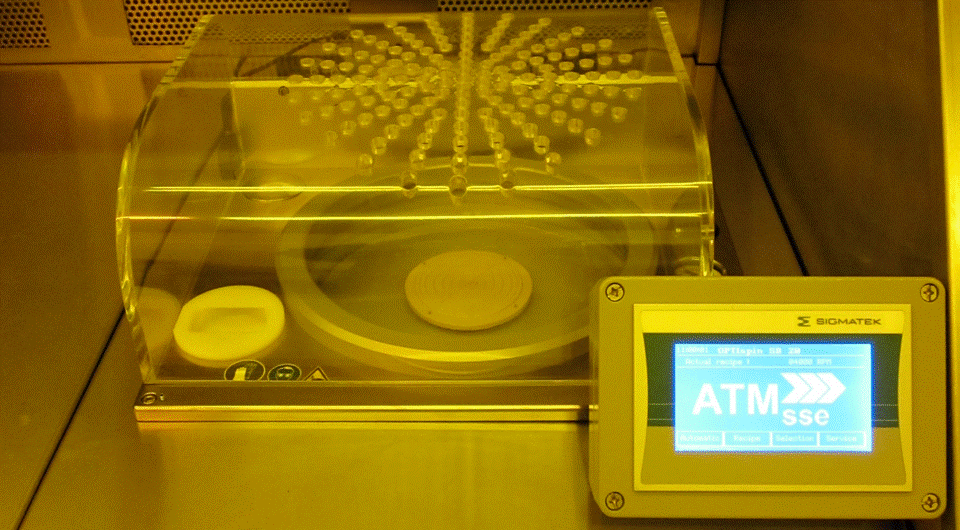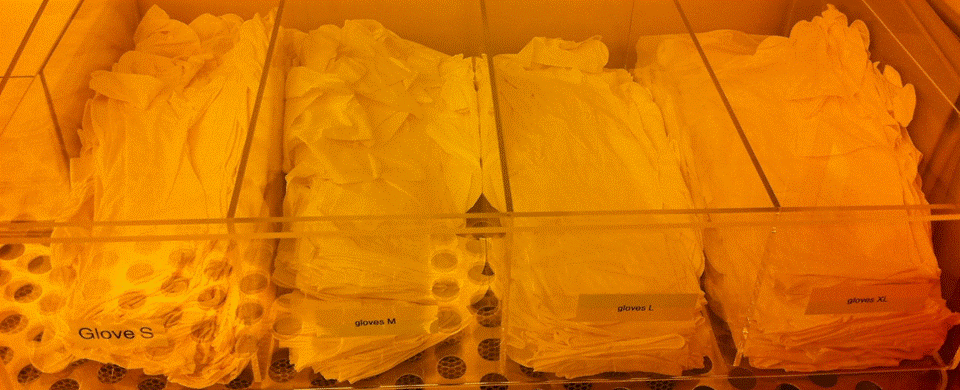
The ATMsse OPTIspin SB20 semi-automated spin coater is a manual coater for small samples and wafers up to 200 mm. The coater is located in the processing room of the ebeam zone (zone 7), and is dedicated to ebeam lithography ONLY !!! Following resists are currently authorized to be coated here: MMA, PMMA, ZEP, CSAR, HSQ, FOX16, Electra92, nLOF. Please do not bring in any other material and do not try to coat any other resist or substance. If you have any special request, please, talk to Zdenek first.
Protective gloves

To use the coater, you must were additional protective gloves. Almost all resists are spun from a solution containing some type of organic solvent (e.g. Anisol, MiBK). Gloves are also needed for the use of the solvents bench when cleaning the spincoater chucks.
Available chucks

Chucks are available for 5inch mask, 150mm wafer, 100mm wafer, 2inch wafer, small chips, and even smaller chips. Please, always select a correct size chuck – make sure that your chip/wafer covers the entire elevated platform of the chuck (especially if it has grooves). Attempting to coat smaller chip/wafer on a larger chuck will result in the resist being sucked into the central vacuum tube, and also in partial coating of the chuck platform surface, which will lead to resist being sucked in on the next coating attempt. If enough resist builds up on the top surface of the chuck, the vacuum may get weaker and the wafer can fly out during the spincoating.
Check vacuum tube, clean and mount chuck

After selecting a proper size chuck, please, clean it with acetone on the solvents bench. Acetone wash needs to be followed by IPA rinse before drying with Nitrogen gun. Inspect the vacuum tube of the coater, it needs to be clean and free of any resist residue. Mount the cleaned chuck properly, the small lever of the vacuum tube must engage with the groove in the leg of the chuck.
Select coating recipe

From the main MENU of the coater, click “Selection”, select desired coating recipe and click “OK”. All recipes are named with their spin speed in rpm. All recipes start with several seconds of a slow ramp up before switching to the spin speed in the name. All recipes run for fixed time of 60 seconds, except the slow spin speeds (below 1000rpm) that are set up for 5 minutes. Custom recipes can be created on demand by CMi staff, but the available selection should prove sufficient for vast majority of uses.
Place wafer on chuck and dispense resist

Place wafer or chip onto the spin chuck and press the vacuum button (VAC) on the coater. The vacuum should engage and clamp firmly the wafer or chip. If it does not, press VAC again, reposition the wafer or chip, and try again. Once the wafer or chip is solidly held by vacuum, you may dispense your resist onto it. Start from the center and dispense in a spiral fashion towards the edges without leaving uncovered areas. Do not dispense all the way to the edge, once the resist solution reaches the edge, it would overflow to the backside of the chip or wafer. Should this happen, remember to carefully wipe the backside clean with acetone (on a cotton swab) before placing the wafer or chip on a hot plate or ebeam holder.
Pipettes for coating can be found in the black box placed above the coater. They are disposable for one time use. Do not return any pipette to the box. After use, make sure the pipette is empty, and dispose of it in a trash bin. DO NOT DISPOSE OF THE PIPETTE IF IT STILL CONTAINS RESIDUAL AMOUNT OF RESIST !!! The solvent would be evaporating from the trash into the room, and can also dissolve some stuff in the trash bin. Any remaining resist from the pipette needs to be emptied into the white receptacle on the left side of the coater.
Do not use larger volumes of resist solution than necessary. It should take no more than 2ml to coat a 100mm wafer, and one or two droplets to coat a small chip.
Run the recipe

Close the cover. Select “Automatic” from the main MENU, verify one last time that proper recipe is chosen, and clock “Start”. Wait until the recipe finishes – there is a several second delay after the spinning stops before the vacuum disengages and the recipe is truly finished. Wait for the vacuum release “sound click” before opening the cover to remove your wafer or chip.